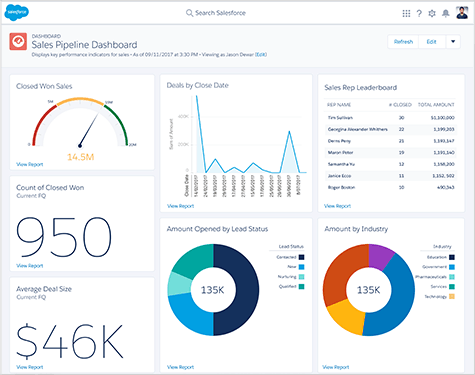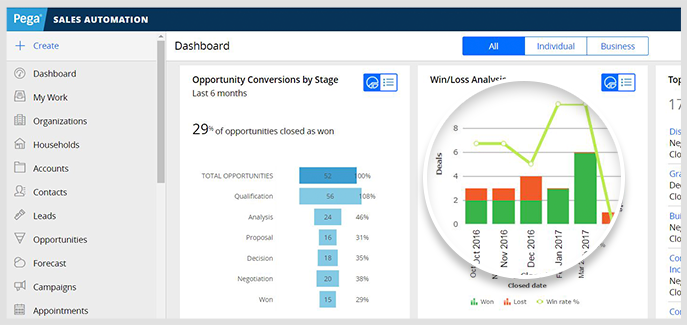Salesforce and Pegasystems could not be further apart in terms of where both companies started their respective customer relationship management (CRM) journeys. Salesforce is currently evolving from providing a simple software-as-a-service (SaaS) application that tracked sales leads to a suite of cloud applications that promise to driver superior customer experiences. Pegasystems first gained recognition as a provider of a business process management (BPM) that the company has subsequently extended to create a set of highly integrated sales and marketing applications.
To provide a similar level of integrated application experience, Salesforce has invested in multiple integration frameworks, including moving to acquire MuleSoft in 2018. At the same time, Salesforce has been acquiring a suite of marketing applications that will one day share a common data object model with its namesake CRM application.
From the perspective of a sales team there’s no doubt Salesforce is the more accessible and feature rich of the two CRM applications, there’s a lot of merit in a Pegasystems approach that views CRM applications as essentially the front-end application through which business processes that span the entire enterprise are integrated. In fact, it’s apparent Salesforce is playing catchup in terms of providing an integrated application experience that spans the entire customer experience management process.
What are the Similarities & Differences between Salesforce and Pegasystems?
Salesforce clearly still view sales teams at the center of the business universe, so it should not come as a surprise that there are more features and capabilities in its core CRM offering. Less clear is to what degree any sales team is going to use any set of application features. Regardless of the application category, most users only wind up regularly employing about 10 to 20 percent of the capabilities in that application. However, in terms of empowering salespeople, there’s a reason why so many sales teams have standardized on Salesforce.
Pegasytems CRM has most of the capabilities any sales team is going to require. The fundamental difference is the level of actionable intelligence that can be surfaced within PegaCRM once it is integrated with the BPM platform developed by Pegasystems. Armed with the data that can be directly accessed from with PegaCRM, salespeople can be provided with a lot more insight into an organization’s supply chain to more accurately inform customers, for example, when a certain quantity of product might be available and delivered.
In the case of Pegasystems, CRM applications are clearly the window through which increasingly digital business processes can be managed.
| Criteria | Pegasytems | Salesforce |
| Cost | Starts at $95 per user per month based on consumption | Starts at $25 per user per month for an annual subscription |
| Ease of Use (10%) |
4 |
4 |
| Implementation (20%) |
4 |
4 |
| Customization (20%) |
4 |
4 |
| Integrations (20%) |
4 |
4 |
| Customer Support (15%) |
4 |
5 |
| Features & Add-ons (15%) |
4 |
5 |
| Total Rating |
4 |
4.3 |
Cost
Salesforce starts at a cost of $25 per user per month that can easily rise as more capabilities are invoked. Salesforce has also built a reputation for not being willing to negotiate on pricing.
Pega CRM is available in a wide variety of flavors, but a subscription to “customer service applications” running in a single tenant cloud platform managed by Pegasystems is listed on the company’s Web site as running anywhere from $97 for “case management” to $295 per user per month for an “omni- channel experience.” Third-party vendors, however, list PegaCRM for sale online at $200 per user per month. Organizations deploying Pega CRM on on-premises can expect even higher total costs.
As is often the case with enterprise software, the total cost of an application is going to vary substantially once all the modules counted, the numbers of users per month is tabulated, and, of course, just how tough a negotiator any customer can be. However, the cost of entry for Pega CRM is higher than Salesforce CRM by several orders of magnitude.
Ease of Use
Salesforce has spent years optimizing the user experience across multiple platforms. The Salesforce CRM application presents a clean user interface that is easily accessible from any desktop or mobile computing device.
The Pegasystems CRM is built more around the notion of case management. Each customer engagement is treated like a case that gets opened. The data from various external systems that might be relevant to that customer engagement then flows into the application in near real time. The goal is to enable salespeople to close a customer engagement without ever having to say they will get back to the customer to answer a question because the data they need is locked up in an application they can’t immediately access.
Salesforce in recent releases has been steadily improving the workflow capabilities built into its core platform, but the Pegasystems approach tends to be more customer centric.
It’s also worth noting that both companies are making major investments in artificial intelligence (AI) to make their applications more accessible. It may even surprise some people to discover that Pegasystems not only started down that path earlier than Salesforce, it remains a little ahead. However, neither Salesforce nor Pegasystems are anywhere near providing salespeople with their own autonomous digital sales assistants, but it’s clear the race to get there is on. It may even turn out that the Pegasystems approach has certain inherent AI advantages because of its ability to aggregate the massive amounts of data across multiple applications in a way all enables AI engines to make more accurate recommendations faster.
Implementation
Salesforce is widely credited with being an early pioneer of software-as-a-service (SaaS) applications and has remained irresolutely committed to that cloud-based approach. For some organizations, however, putting data in the cloud remains a non-starter.
Pegasystems CRM is designed to be deployed on-premises or in a public cloud or via Pega Cloud, an instance of a single-tenant cloud computing environment managed by Pegasystems.
While Salesforce is delivered as a SaaS application, organizations will find that there is a significant gap between merely activating a software license and being able to effectively employ Salesforce to manage a sales process. That work often requires either hiring someone with a lot of Salesforce expertise or relying on a third-party service provider.
A robust Pegasystems CRM implementation, especially one that involves the company’s BPM platform, will almost invariably require systems integrator level expertise, which will have a significant impact on the total cost of acquisition and ongoing maintenance.
Customization
Salesforce provides a rich set of options for customizing its CRM application, most notably in a series of low-code Lightning application development tools that are simple enough for end users that have some knowledge of how to construct an application to employ on their own. Most recently, Salesforce has begun to make elements of that low-code platform available as open source code.
Pegasystems employs a set of visual tools to enable organizations to customize any Pega application. Those tools are more accessible to the average end user compared to Salesforce tools that require at the very least a “super user” to employ. As such, organizations are going to find it a little easier to customize Pega CRM once they get it up and running.
Integrations
Salesforce provides access to a raft of tools and well-defined application programming interfaces (APIs) to foster integration. In addition, Salesforce last year moved to acquire MuleSoft, a provider of application integration software and services. In addition, Salesforce makes available multiple platform-as-a-service (PaaS) environments
Pegasystems focuses on integration at the BPM level, which is a much higher level of abstraction. Achieving that level of integration, however, requires organizations to standardize on the Pega BPM platform.
Customer Support
Both Pegasytems and Salesforce provide access to customer support. However, Salesforce has built a massive end user community through which sales administrators and developers provide each other with mutual support and share best practices.
Features & Add-ons
Salesforce makes available more features within its CRM application. Salesforce has a significant edge in terms of the size and scope of the app store it makes available to discover a wide range of add-ons and additional modules, such as marketing automation tools, developed by both Salesforce and its third-party partners. Core the Salesforce strategy is common customer record that it allows all its own add-on software and third-party partner software to invoke via a common object model. Salesforce is in the process of extending that model out to applications it has acquired and third-party vendors may often provide entirely different user interfaces, so the level of integration can be uneven.
Pegasystems has pursued a path through which it ensures all the applications it provides share the same code base, which provides a more seamless user experience across an application portfolio that in addition to CRM includes marketing and customer service applications.
In addition, Pegasystems has created implementations of suites of its applications that are optimized for specific vertical industries.
Related CRM Comparison Articles
How to Choose the Best CRM Solution to Fit Your Needs
Deciding between Pega CRM and Salesforce will come down to the scope of the organization’s ambition. If the goal is to empower the sales organization to sell more products and services, it’s hard to ignore all the capabilities of Salesforce platform that millions of salespeople are familiar with already.
However, if the goal is to drive a digital business transformation initiative the Pegasystems approach could prove to be more cost effective over time. The initial cost of entry is high, but over time the total cost of ownership could not only wind up be lower, the flexibility afforded by standardizing on single code base might be much higher simple because the cost of making changes to an existing deployment will not be as nearly as high.
As is often the case when it comes to enterprise software, it really is a matter of how much cost does an organization want to absorb upfront versus somewhere down the road. In the case of Pegasystems, more organizations appear to be thinking through that equation. The market research firm AppsRuletheWorld notes Pegasystems saw a 17 percent growth in CRM sales in 2018. However, that compares to a 23 percent growth rate on a much larger base of revenue for Salesforce. The challenge facing organizations is determining which of these are the best CRM software solutions for individual situation.




